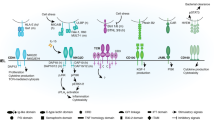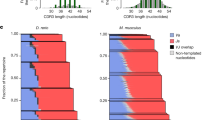Abstract
TLYMPHOCYTES are found not only as recirculating cells in the lymphoid system, but also as immobile cells in certain epithelia. T-cell antigen receptors (TCR) of both α / β and γ / δ-heterodimer subtypes can exhibit an extremely high degree of diversity. The diversity of α / β TCRs derives from the use of a large number of variable (V) gene segments, as well as junctional diversity generated during rearrangement of these segments, whereas the diversity of γ / δ TCRs derives largely from junctional elements, with a smaller contribution from a limited number of V gene segments1. Many T cells in the epidermal and intestinal epithelia of mice express TCR composed of γ / δ heterodimers2–5,14,15. We demonstrate here that γ/δ TCRs of T cells in both these tissues are restricted in V gene usage, with different elements predominating. The TCR junctional diversity of epidermal T cells, however, is extremely limited, whereas that of intestinal T cells is extremely diverse. The distinctive features of these two populations suggest that they develop or are selected differently for particular tissue-specific functions.
This is a preview of subscription content, access via your institution
Access options
Subscribe to this journal
Receive 51 print issues and online access
$199.00 per year
only $3.90 per issue
Buy this article
- Purchase on Springer Link
- Instant access to full article PDF
Prices may be subject to local taxes which are calculated during checkout
Similar content being viewed by others
References
Davis, M. M. & Bjorkman, P. J. Nature 334, 395–402 (1988).
Koning, F. L. et al. J. Immun. 141, 2057–2062 (1988).
Stingl, G. et al. Proc. natn. Acad. Sci. U.S.A. 84, 2430–2434 (1987).
Kuziel, W. A. et al. Nature 328, 263–266 (1987).
Bonyhadi, M., Weiss, A., Tucker, P. W., Tigelaar, R. E. & Allison, J. P. Nature 330, 574–576 (1987).
Asarnow, D. M. et al. Cell 55, 837–847 (1988).
Havran, W. L. & Allison, J. P. Nature 335, 443–445 (1988).
Havran, W. L. et al. Proc. natn. Acad. Sci. U.S.A. 86, 4185–4189 (1989).
McConnell, T. J. et al. J. Immun. 142, 2924–2931 (1989).
Alt, F. W. & Baltimore, D. Proc. natn. Acad. Sci. U.S.A. 79, 4118–4122 (1982).
Hagiya, M. et al. Proc. natn. Acad. Sci. U.S.A. 83, 145–149 (1986).
Chien, Y. H. et al. Nature 330, 722–727 (1987).
Garman, R. D., Doherty, P. J. & Raulet, D. H. Cell 45, 733–742 (1986).
Goodman, T. & LeFrancois, L. Nature 333, 855–858 (1988).
Bonneville, M. et al. Nature 336, 479–481 (1988).
Klein, J. R. J. exp. Med. 164, 309–314 (1986).
LeFrancois, L. & Goodman, T. Science 243, 1716–1718 (1989).
Takagaki, Y., DeCloux, A., Bonneville, M. & Tonegawa, S. Nature 339, 712–714 (1989).
Iwamoto, A. et al. J. exp. Med. 163, 1203–1212 (1986).
Pelkonen, J., Traunecker, A. & Karjalainen, K. EMBO J. 6, 1941–1944 (1987).
Elliott, J. F., Rock, E. P., Patten, P. A., Davis, M. M. & Chien, Y. H. Nature 331, 627–631 (1988).
Korman, A., Marusic-Galesic, S., Spencer, D., Kruisbeek, A. & Raulet, D. H. J. exp. Med. 168, 1021–1040 (1988).
Lacy, M. J., McNeil, L. K., Roth, M. E. & Kranz, D. M. Proc. natn. Acad. Sci. U.S.A. 86, 1023–1026 (1989).
Allison, J. P. et al. Immunol. Res. 7, 292–302 (1988).
Lindquist, S. A. Rev. Biochem. 55, 1151–1191 (1986).
O'Brien, R. L. et al. Cell 57, 667–674 (1989).
Janis, E. M., Kaufmann, S. H. E., Schwartz, R. H. & Pardoll, D. M. Science 244, 713–716 (1989).
Sullivan, S., Bergstresser, P. R., Tigelaar, R. E. & Streilein, J. W. J. invest. Dermatol. 84, 491–495 (1985).
Saiki, R. K. et al. Science 239, 487–491 (1988).
Author information
Authors and Affiliations
Rights and permissions
About this article
Cite this article
Asarnow, D., Goodman, T., LeFrancois, L. et al. Distinct antigen receptor repertoires of two classes of murine epithelium-associated T cells. Nature 341, 60–62 (1989). https://doi.org/10.1038/341060a0
Received:
Accepted:
Issue Date:
DOI: https://doi.org/10.1038/341060a0
This article is cited by
-
Mechanisms of activation of innate-like intraepithelial T lymphocytes
Mucosal Immunology (2020)
-
Functions of skin-resident γδ T cells
Cellular and Molecular Life Sciences (2011)
-
Dust acoustic solitary waves in dusty plasma with nonthermal ions
Astrophysics and Space Science (2009)
-
Environmentally Responsive and Reversible Regulation of Epidermal Barrier Function by γδ T Cells
Journal of Investigative Dermatology (2006)
-
Immunosurveillance and Immunoregulation by γδ T Cells
Journal of Investigative Dermatology (2006)
Comments
By submitting a comment you agree to abide by our Terms and Community Guidelines. If you find something abusive or that does not comply with our terms or guidelines please flag it as inappropriate.



